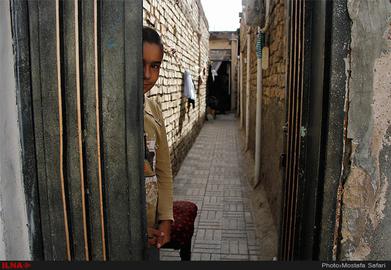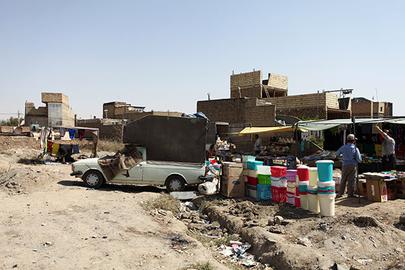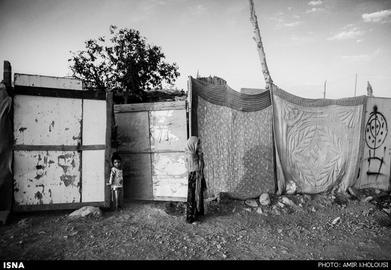What is it like to live on the margins of a metropolis in Iran today? Those who do are confronted with some of the most serious crises facing the country today, with social, economic, political and security repercussions. Various groups and organizations have reported on and collected data about the predicaments of margin-dwelling in Iran but, despite the significance of the subject, the reliable statistics needed for in-depth political, social and economic analyses either do not exist or have not been made public.
This is the second in a series of reports on living on the margins in Iran, introducing the province of Razavi Province in the northeast of the country. Another article in the series will look in-depth at margin-dwelling in the county's biggest city, Mashhad, as well as other cities in the province. IranWire will aim to use available statistics and data, as incomprehensive of some of it might be, to arrive at an accurate picture of the phenomenon of living on the margins in Iran and the crises emerging from it.
Mashhad: Iran’s Fire Alarm
The phenomenon of margin-dwelling in Razavi Khorasan province and its capital Mashhad is more visible than in any other place in Iran. Not only do the statistics point to the painful conditions of those who live in the margins of cities in this province, history shows that signs of any social and political crises in Iran tend to appear in this region first.
Mashhad is a like a fire alarm for developing crises in Iran. From the 1992 riots to the nationwide protests that started in late December 2017, unrest and major events — be they social, political or economic — usually unfold first in Mashhad and Razavi Khorasan before spreading to other parts of Iran.
The unbridled construction boom in the late 2000s started in Mashhad, and so did the first signs of the slump a few years later. Razavi Khorasan is both the capital of troubled big financial institutions and the record-holder for the number of divorces and abandoned children. The holy city of Mashhad, nicknamed “capital of the shadow government”, is also home to Astan Quds Razavi, the largest religious endowment in Iran. Sermons by Ahmad Alamolhoda, Mashhad’s Friday Prayers Leader, play a more important role in shaping political crises that the sermons delivered at Tehran’s Friday prayers.
Margin-dwelling and the concentration of economic and political entities is what makes this city, and Razavi Khorasan by extension, an early indicator of crises in Iran.
Introducing Razavi Khorasan
Razavi Khorasan Province (Source: Google Maps)
Population
Razavi Khorasan is the most populated Iranian province after Tehran. According to the 2016 census, the population of the province was 6.5 million, half of whom live in Mashhad. Between 2011 and 2016, the population of Razavi Khorasan grew by 7.3 percent, one percent higher than the average population growth in Iran during those five years. In the same period the population of Mashhad grew even faster — by 9.2 percent, 2.5 percent more than Tehran and 1.8 percent higher than the population growth in major metropolitan areas.
The population density of Razavi Khorasan is 54 per square km while the population density in Mashhad is 8,700 per square km — comparable to cities like Rio de Janeiro, Yokohama and Madrid. In Nishapur, the province’s second largest city, the population density is at least 1,000 per square km.
But the population of Mashhad itself is not evenly distributed. In some parts of the city, like District 12, the population density is less than 2,000 per square km, while in areas such as District 4 the density reaches to almost 20,000 per square km — around 5,000 more than the average density in Tehran, which is 15,000 per square km.
The Economy
The economy of Razavi Khorasan and particularly that of Mashhad also has a special place within the overall Iranian economy. According to the Statistical Center of Iran, for the years between 2011 and 2015, the province’s share of gross national product (GNP) was 5.5 percent, which places it fourth after Tehran, Khuzestan and Isfahan. But if one takes petroleum out of the equation, the province’s share goes up to six percent and places it third, before Khuzestan.
The financial and business organizations owned by Astan Quds Razavi are based in Mashhad. No reliable data about this group of companies is available, but what is known for certain is that the holding conglomerate is made up of close to 40 business entities, which are active in a wide variety of areas — from car manufacturing, textiles, carpet weaving, mining, oil and gas to financial services, construction, pharmaceuticals, agriculture, animal husbandry and their associated industries.
What is more, all these companies are tax-exempt because they belong to a religious endowment. This exemption means that they are at least 25 percent — the percentage of corporate tax normal businesses pay — ahead of their competitors in both public and private sectors.
According its official website, the Razavi Economic Organization, established in 1998, it is active “in the form of more than 70 companies and institutions” with “more than 12,000 people” who work “directly and indirectly in companies and the subsidiary companies affiliated with this organization.”
To get a general idea of the financial weight of Astan Quds Razavi, it is useful to point out that in early 2017, the government of the Islamic Republic owed the organization about 3.45 trillion tomans, close to $808 million. The number is almost equal to the amount the government budget expects to receive this year from the whole province of Razavi Khorasan.
Tourism and Pilgrimage
The holy city of Mashhad is the most popular city in Iran for tourism. According to statistics published by Iran’s Planning and Budget Organization, in spring 2016, with more than 13 million visitors spending at least one night in the city, Mashhad had the highest number of domestic tourists. It also stands well above other Iranian cities in terms of the number of foreign tourists and pilgrims.
According to 2016 statistics from Iran’s Cultural Heritage, Handicrafts and Tourism Organization, close to 530,000 tourists flew into Iran via Mashhad’s airport, second only to Tehran’s Imam Khomeini Airport, with 970,000 tourists. The number of people using the Mashhad airport is almost eight times more than the number of people using Shiraz airport, the third busiest air travel hub in Iran.
Based on statistics published by Mashhad Municipality, during the Iranian calendar year 1394 (March 21, 2015 to March 20, 2016), more than 1.22 million foreign pilgrims visited Mashhad. This is close to one fourth of the total number of foreign tourists who visited Iran in that year.
The Religious Standing
Among Shias Muslims’ “Fourteen Infallibles,” only the eighth imam, Imam Reza, is buried in Iran, and he is buried in Mashhad. After Mecca, Mashhad is the second biggest magnet for Shia pilgrims and its economic, political and social conditions are shaped by this religious identity.
According to the 2011 census, around 99.5 percent of Razavi Khorasan’s population are Muslims. However, it is not clear how many of them are from non-Shi’ite Muslim minorities. Based on unofficial estimates, more than 700,000 Sunnis live in the province.
This has worried some Shia religious authorities, especially hardliners such as Ayatollah Naser Makarem Shirazi. “I have warned the authorities that if they cannot find a way to counter...the Wahhabis’ attempts to change the population fabric today, we may well reach a point where we will not be able to do anything about it,” he was quoted as saying about the increase in Razavi Khorasan’s Sunni population. “Recently the Wahhabis have [been very active] inside Iran and the sources of these activities are foreign countries. They also carry out their projects inside Iran very fast. Iran is currently the center of Shi’ism and that is why they want to fight Iran. One of their main aims is to change the fabric of the population and increase the number of Sunnis. In this regard, they have been busy buying land, homes and commercial real estate from the Shias. Pressuring the Shias to migrate from certain areas to change the population ratio in terms of religion are among the other actions taken by the Wahhabis.”
Political and Security Status
Politically, Mashhad is the most important city in Iran after the capital, Tehran. In recent years, however, Mashhad has practically turned into the capital for the Iranian hardliners’ “shadow government.” But in Mashhad, hardliner politics has not remained confined to the political arena, and has put its deep marks on the city’s economy, culture and society. This, in turn, has led to a brittle security situation compared to other parts of Iran. Government officials have officially warned that terrorism is a real threat in Mashhad.
Migration
These religious and economic factors have turned Mashhad into a magnet for migrants. Between 2006 and 2011, more than 190,000 Iranians migrated to Mashhad. In 2006, the population of Mashhad stood at over 2.427 million but, according to the 2011 census, this number jumped to 2.766 million, an increase of 339,000. If one breaks down this last number into migrants and those who were born in the city, we can see that during this five-year period more than 55 percent of the population increase was due to migration.
Read the full Living on the Margins in Iran series:
Living on the Margins in Iran: An Introduction
Living on the Margins in Iran: Razavi Khorasan
Living on the Margins in Iran: Mashhad and the Cities of Razavi Khorasan
Living on the Margins in Iran: East Azerbaijan
Living on the Margins in Iran: Bandar Abbas and Hormozgan Province
Living on the Margins in Iran: Chabahar and the Province of Sistan and Baluchistan
Living on the Margins in Iran: The Rise and Fall of Khuzestan
Sources in Persian:
بحران آسیب های اجتماعی در مشهد, Donya-e Eqtesad, January 22, 2018
خراسان، پایتخت موسسههای مالی بحران زده, Deutsche Welle (DW), February 3, 2018
سه دلیل اصلی طلاق در خراسان رضوی, Samen Press, January 30, 2017
مشهد، رکورددار «کودکان رها شده» در ایران, IranWire, June 9, 2018
اعتراض حاشیهنشینان, Tejarat-e Farda, January 13, 2018
چکیده نتایج سرشماری عمومی نفوس و مسکن – 1395, Statistical Center of Iran (PDF), 2018
جمعیت و مساحت مناطق شهرداری مشهد, Statistical Center of Iran (PDF), 2018
حسابهای منطقهای ۹۴-۱۳۹۰, Statistical Center of Iran, 2017
عملکرد اقتصادی آستان قدس رضوی در اتاق شیشه ای, Eghtesad News, August 5, 2017
لایحه بودجه سال 1397کل کشور, Iran’s Planning and Budget Organization (PDF), 2017
نتایج آمارگیری از گردشگران ملی، بهار 1395, Iran’s Planning and Budget Organization (PDF), 2017
آمارنامۀ شهر مشهد، 1394, Mashhad Municipality [PDF], 2017
جذب بیشتر گردشگران خارجی, Rouhani Meter, 2018
چرا «اهل سنت مشهد» مسأله شده؟, T News, December 5, 2017
واقعيات سکونتگاههای غيررسمی را در سه دهه گذشته مخفی کرديم, Ministry of Roads and Urban Development (MRUD), March 18, 1015
visit the accountability section
In this section of Iran Wire, you can contact the officials and launch your campaign for various problems


























comments